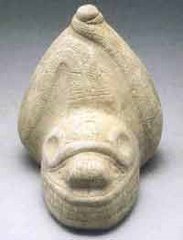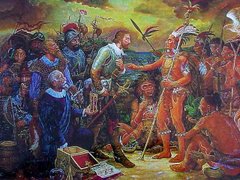Did You Know: The cashew tree (Anacardium occidentale) is said to have originated in northeast Brazil, however, it
is widely distributed through tropical South and Central America and the
Caribbean. In Borikén (Puerto Rico) and Kiskeia (Dominican Republic), what are
understood to be Taino words for cashew are still used today, incorporated in
the local Spanish language including kahuil (prounounced kah-hoo-eel), pahuil (pajuil), and pauhil. An
additional, more rarely used term for cashew in Borikén is pahui (pajuy/pah-hoo-ee). All
these terms seem to be related linguistically to the term for cashew used in indigenous
Tupian languages - acajú
- said to mean
“nut that produces itself.” The cashew tree is large and evergreen, growing to
10-12m (32 ft) tall. It produces a type of fruit (known in English as ‘cashew
apple’ or ‘marañón’
in Spanish), which is edible, and has a strong "sweet" smell
and a sweet taste. The cashew nut is really a seed and a good source of
antioxidants, but it needs to be roasted or steamed as it contains urushiol, a resin that can cause skin rashes, and can be toxic when ingested. Urushiol is also present in the tree's leaves. Traditional medicinal uses of the cashew tree include grinding the
seeds into a poultice for treating snakebites, and the use of the fruit, bark, and leaves for
many other purposes including anti-fungal activity, for sores and rashes, or as
an antipyretic, and for antidiarrheal applications. – UCTP Taino News
Showing posts with label cashew. Show all posts
Showing posts with label cashew. Show all posts
Monday, March 17, 2014
Cashews and Taino People
Tuesday, July 20, 2010
The Traditional Taino Diet
 Did You Know: The traditional diet of the Taino was based mainly on community cultivated agricultural products, supplemented with wild fruits as well as fishing, and limited hunting. Root tubers such as yuka (manioc) and batata (sweet potatoes) were cultivated along with many other diverse food crops like maisi (corn), mani (peanuts), calabasa (pumpkin), iaiama (pineapple), cahuil (cashews), beans, aji (peppers) etc. The hunting of small game such as birds, small mammals, and reptiles such as iguanas, and snakes was also practiced daily by community members. The ocean and rivers were also exploited in a sustainable manner for their bountiful resources. The Taino harvested edible marine-life, including conch, oysters, lobsters, clams, and crabs. Fish were caught with bone and shell hooks, large mesh nets, nasa (fish traps), spears, and bows and arrows. Some of the larger marine-life that the Taino encountered and hunted included the manati (sea cow), tuna, sea turtles, and sharks. Occasionally, even a pilot whale was taken for by various communities. Taino survival was secured by the application of ancient traditional knowledge, which included practical and medicinal knowledge of plants, an deep understanding and symbiotic relationship with their environment, and the ability to apply appropriate tools and techniques. - UCTP Taino News © 2010
Did You Know: The traditional diet of the Taino was based mainly on community cultivated agricultural products, supplemented with wild fruits as well as fishing, and limited hunting. Root tubers such as yuka (manioc) and batata (sweet potatoes) were cultivated along with many other diverse food crops like maisi (corn), mani (peanuts), calabasa (pumpkin), iaiama (pineapple), cahuil (cashews), beans, aji (peppers) etc. The hunting of small game such as birds, small mammals, and reptiles such as iguanas, and snakes was also practiced daily by community members. The ocean and rivers were also exploited in a sustainable manner for their bountiful resources. The Taino harvested edible marine-life, including conch, oysters, lobsters, clams, and crabs. Fish were caught with bone and shell hooks, large mesh nets, nasa (fish traps), spears, and bows and arrows. Some of the larger marine-life that the Taino encountered and hunted included the manati (sea cow), tuna, sea turtles, and sharks. Occasionally, even a pilot whale was taken for by various communities. Taino survival was secured by the application of ancient traditional knowledge, which included practical and medicinal knowledge of plants, an deep understanding and symbiotic relationship with their environment, and the ability to apply appropriate tools and techniques. - UCTP Taino News © 2010
Labels:
aji,
batata,
Caribbean Indigenous Peoples,
cashew,
iguana,
manati,
mani,
pineapple,
Taino,
Taino words,
UCTP Did You Know Files,
UCTP Taino News,
yuca
Subscribe to:
Posts (Atom)






